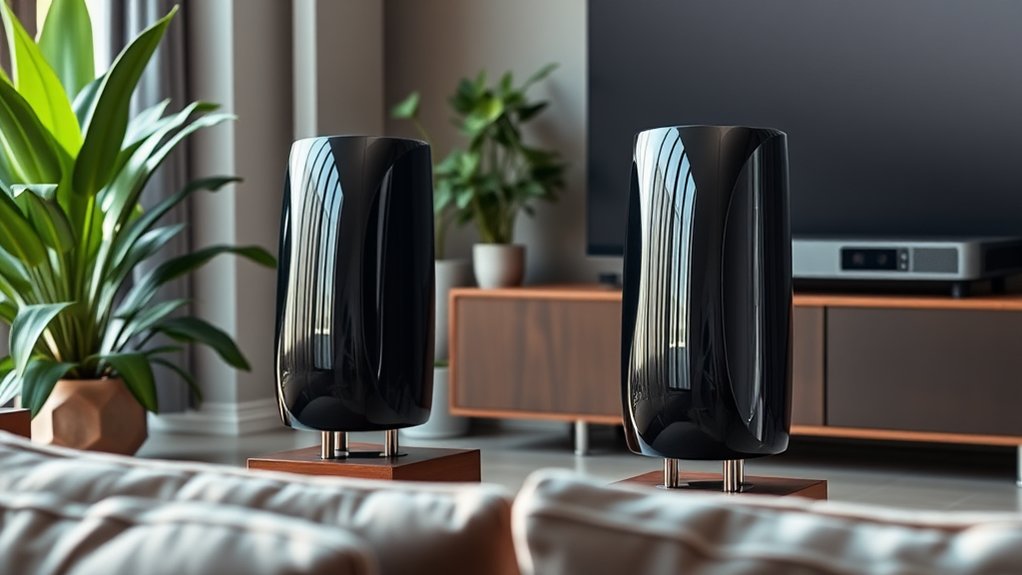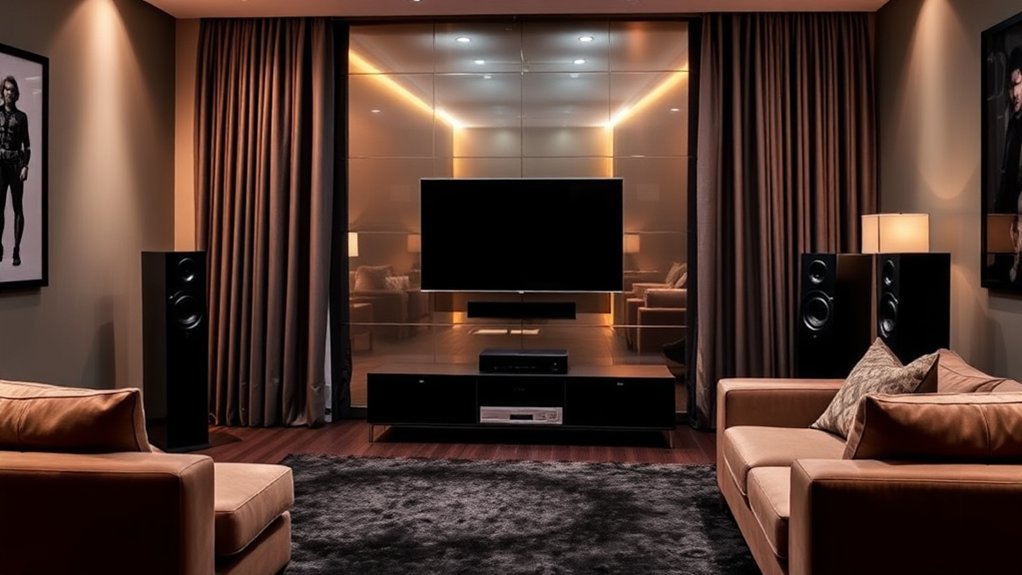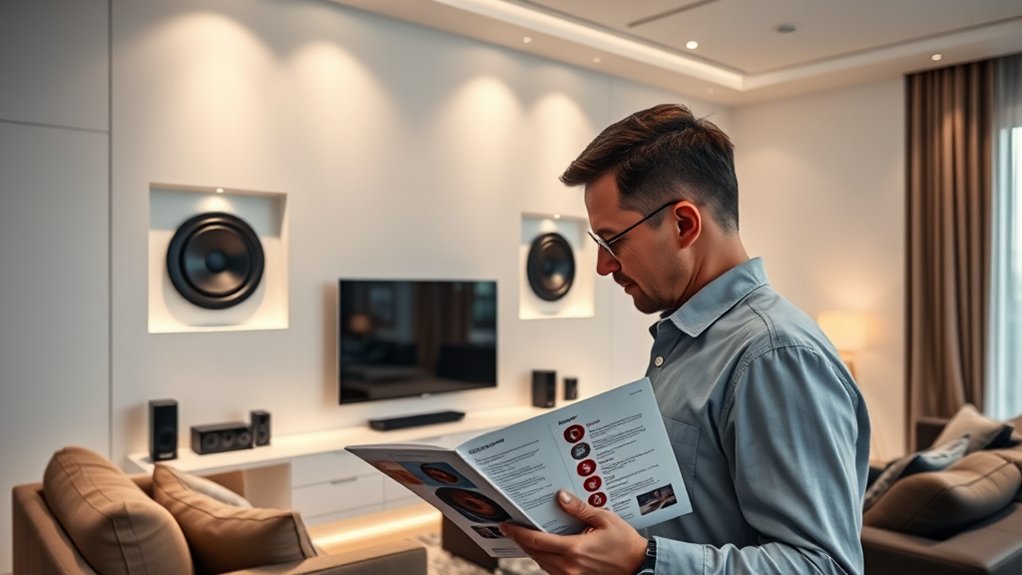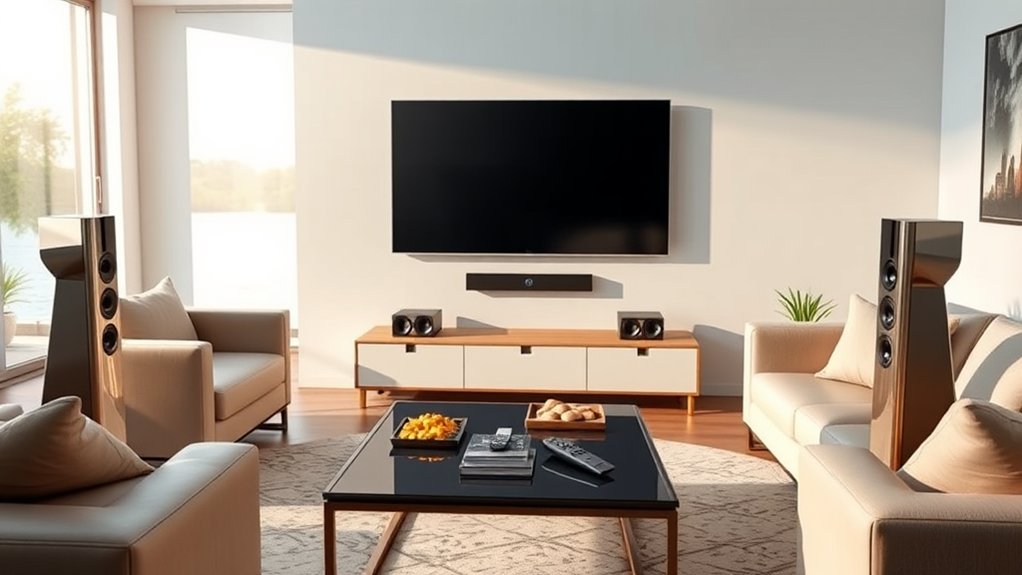When you’re choosing the best wireless home theater speakers, start by considering channel configurations; more channels typically mean a richer sound experience. Think about the types of speakers that fit your space, like soundbars or surround systems. Check compatibility with your devices and pay attention to sound quality, something you’ll want for full immersion. And don’t forget about placement! Proper setup can make or break your audio experience—stick with us to uncover more tips for a stellar sound system.
Key Highlights
- Assess the channel configuration needed for your space, such as 5.1 or 7.1, to enhance audio experience and immersion.
- Ensure compatibility with devices and check wireless protocols like Wi-Fi and Bluetooth for reliable connectivity.
- Prioritize sound quality by selecting speakers with a balanced frequency response and high power handling capacity for distortion-free audio.
- Consider essential features like surround sound capability and customizable equalizer settings to match your room’s acoustics.
- Evaluate placement options and flexibility, aiming for optimal surround speaker positioning to achieve an immersive home theater experience.
Understanding Channel Configurations
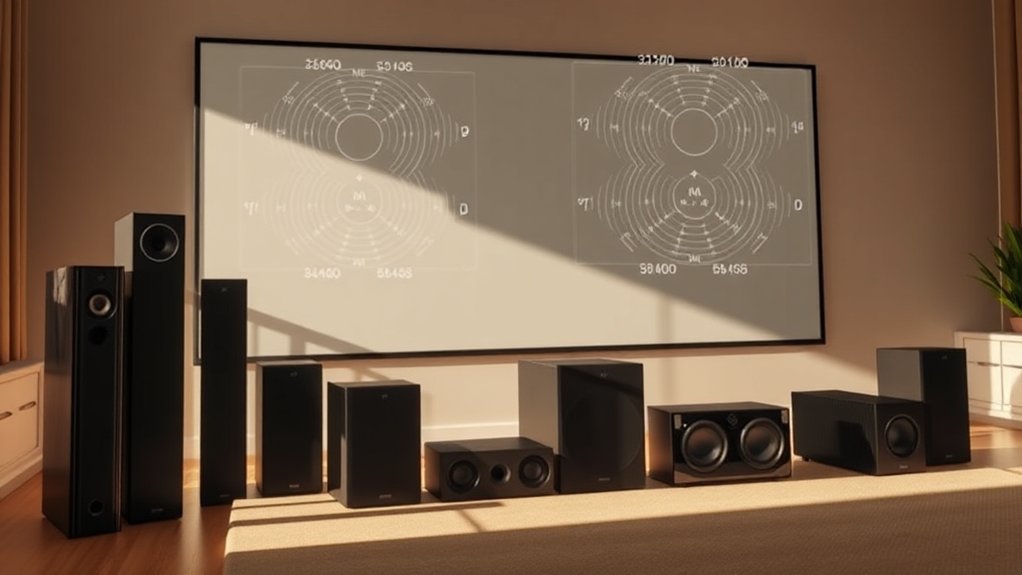
When you’re diving into the world of wireless home theater systems, understanding channel configurations is like getting the lay of the land before you start setting up your audio paradise. The channel count, like 5.1 or 7.1, tells you how many speakers and subwoofers are involved; the first number is the speakers, whereas the second denotes subwoofers. More channels, such as 9.1 or 11.1, add height and wide channels, enriching your sound experience by creating a fuller, more immersive audio environment. Wireless sound systems can provide flexible configurations and eliminate clutter from speaker wires, enhancing both aesthetics and functionality in your setup. Additionally, custom high-end home theaters can be tailored to fit your specific audio needs, ensuring a top-notch listening experience. Many soundbars without subwoofers also feature advanced audio processing technologies that can significantly enhance sound quality in compact designs.
Think of it as arranging a band—the more instruments you have, the richer the music. But remember, proper placement of these speakers is essential; even the best setup can sound flat if your speakers aren’t positioned perfectly.
Types of Wireless Speakers
In the domain of home audio systems, knowing the types of wireless speakers available can make all the difference in crafting your ideal listening environment.
You’ve got soundbar systems, which offer Bluetooth connectivity for pairing with your gadgets and often come with a subwoofer. Additionally, many wireless surround sound systems eliminate the hassle of speaker wires, providing an immersive audio experience without the clutter of cables, thanks to advanced audio technologies like Dolby Atmos and DTS:X that enhance the sound quality.
Then there are wireless bookshelf speakers, compact yet surprisingly powerful, perfect for tight spaces and stylish enough to blend with your decor. These speakers often feature Bluetooth connectivity for easy access to your music library.
If you’re looking to fill your whole house with sound, multiroom wireless speakers let you control music across various rooms through one interface.
Finally, wireless surround sound systems provide that immersive experience for movie nights, minus the hassle of wires. Who said quality sound couldn’t coexist with convenience?
Importance of Connectivity and Compatibility
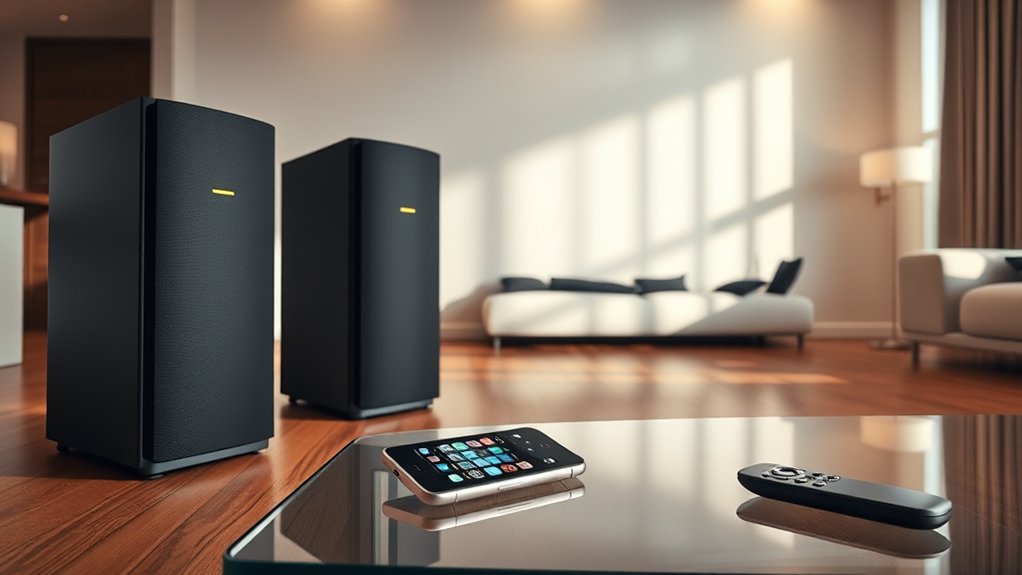
Choosing the right wireless home theater speakers means understanding the importance of connectivity and compatibility, as these factors play a significant role in your overall audio experience.
First, consider the different wireless protocols: Wi-Fi is usually best for multi-room setups where range matters, whereas Bluetooth offers wider compatibility but has its limitations in range and audio quality. Many modern systems, like the Samsung HW-Q950A, utilize Dolby Atmos to enhance the immersive audio experience.
When choosing wireless speakers, consider Wi-Fi for range in multi-room setups and Bluetooth for broader compatibility, though with some limitations.
You’ll additionally want to verify your speakers work effortlessly with your devices—think TVs, receivers, or even that old projector.
And let’s not forget impedance matching; you wouldn’t want to fry your speakers, right?
In the end, a system with the proper connectivity not only improves sound but likewise makes your setup easier and tidier. After all, who likes a spaghetti mess of wires? Additionally, consider that using wireless technology for speaker connectivity enhances placement flexibility and makes installation a breeze.
Evaluating Sound Quality and Performance
After you’ve made certain your wireless speakers will play nice with your devices and won’t leave you tangled in a web of cords, it’s time to focus on sound quality and performance.
You want speakers that handle loud volumes without distorting sound; think of them as musicians who maintain their harmony even when the crowd goes wild. Look for those with a linear frequency response, ensuring movies sound as intended from bass to treble. Additionally, check the power handling—your speakers need to take the amp’s power without breaking a sweat. Remember, if you’re throwing your system together like a last-minute party, achieving a balanced soundstage is vital—after all, who wants dialogue drowned out by a cinematic explosion? The Vizio M512a-H6 soundbar, for instance, offers an immersive audio experience with Dolby Atmos and DTS:X support, enhancing your overall listening experience.
Room Acoustics and Speaker Placement
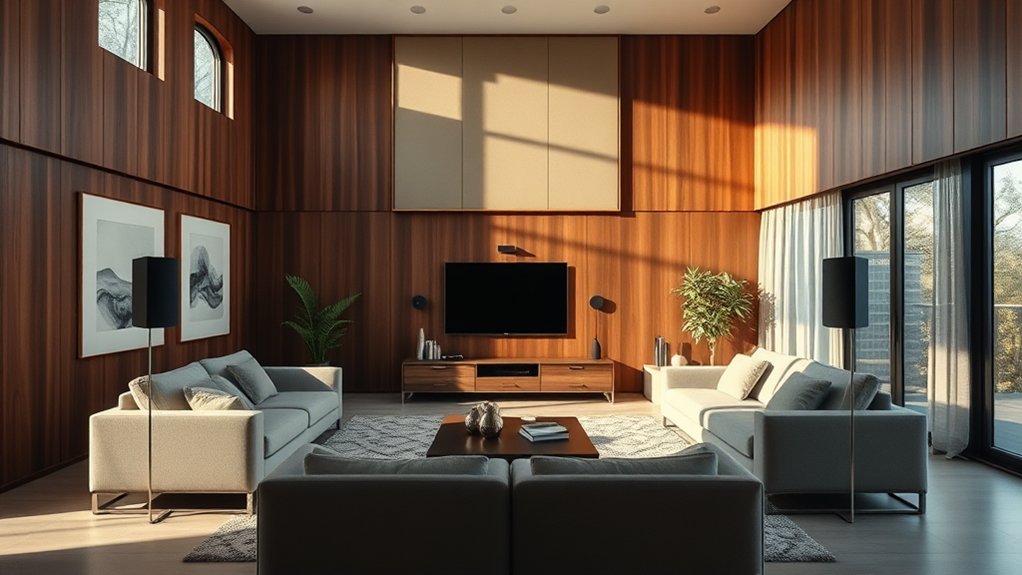
When you’re setting up your wireless home theater speakers, understanding room acoustics and speaker placement can’t be overlooked, as these factors play a crucial role in achieving that cinematic experience right in your living room.
For example, larger rooms benefit from floor-standing speakers, allowing for broader sound coverage, whereas smaller ones thrive with bookshelf or wall-mounted speakers to avoid crowding.
You’ll want your front left and right speakers spaced evenly from your listening position, with tweeters at ear level for peak clarity.
Don’t forget to experiment with angling speakers and pulling them away from walls to reduce bass boom.
After all, who wants a booming bass that echoes as if you’re in a cave?
Just remember, placement is key!
Budgeting for Your Wireless Home Theater
Establishing a budget for your wireless home theater speakers can feel like maneuvering through a maze, especially when you consider all the options available.
First, decide if you’re looking for an entry-level system starting around $500, or if you prefer to splurge on a high-end model exceeding $2,500. But remember, it’s not just about the speakers you’re buying; you’ll want to factor in add-ons like subwoofers and additional surround speakers.
Additionally, keep in mind those “must-have” features, such as wireless range and audio quality. Consider options like the compact design of models such as the Sony HT-S100F, which makes them ideal for various room layouts.
Finally, don’t overlook potential ongoing costs, like firmware updates or electricity bills—after all, who doesn’t want to be surprised by extra expenses later?
Balancing these aspects can refine your choices effectively.
Brand Reputation and Customer Reviews
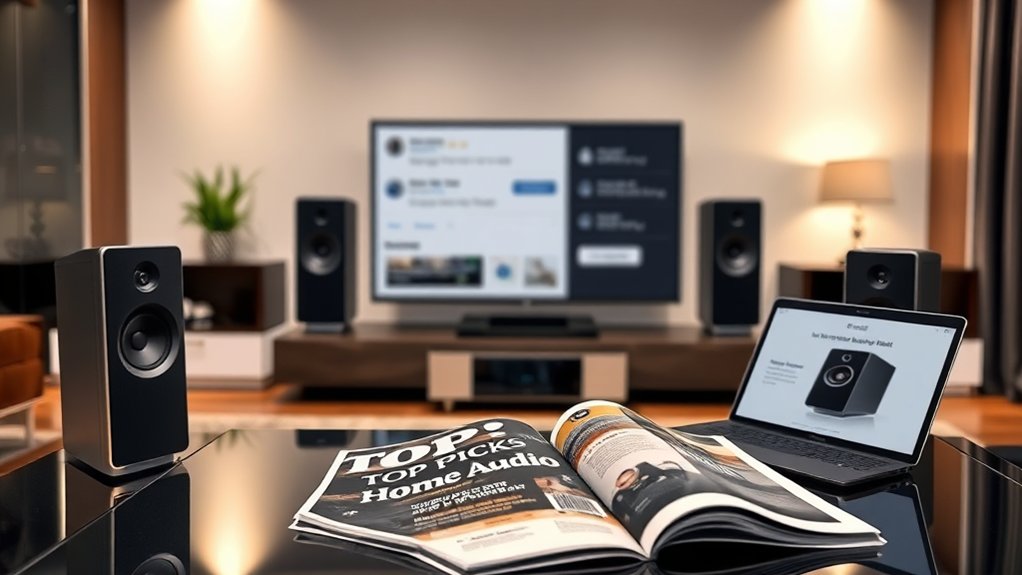
Choosing the right wireless home theater speakers involves more than just crunching numbers—it’s also about understanding brand reputation and the feedback from those who’ve already taken the plunge.
When you opt for a well-known brand, you’re often guaranteed reliability and post-purchase support, like warranties and helpful customer service.
Check customer reviews, as a flurry of positive feedback usually signals durability, performance, and overall satisfaction.
Keep an eye out for consistent mentions of connection stability or sound quality; they can reveal hidden gems—or potential pitfalls.
In short, pairing a reputable brand with glowing reviews is like getting a chef’s recommendation; it gives you confidence that you’re making a savvy choice for your audio experience. Additionally, look for brands like Sony that offer premium soundbar capabilities to ensure an immersive audio experience.
Wireless Setup and Integration Tips
Setting up wireless home theater speakers might seem challenging, but you can make it a breeze with the right approach.
First, choose the right wireless transmission method—Wi-Fi offers multi-room audio, whereas Bluetooth is handy for quick pairings. If you’re leaning towards stability and low latency, consider proprietary systems that create dedicated networks.
Once you have your setup, connect your AVR’s Zone 2 preamp output to the wireless transmitter using RCA cables. Be mindful of interference; switching channels can help dodge annoying distractions.
Properly mount your speakers according to the 7.1 layout for best sound, and don’t forget that even wireless speakers need power. Additionally, you might want to consider soundbars that support Dolby Atmos, as they can enhance your overall audio experience significantly.
Essential Features to Look For

When diving into the world of wireless home theater speakers, you’ll want to keep an ear out for several important features that can make or break your cinematic experience.
First, focus on sound quality—look for crisp highs, rich mids, and deep bass for an immersive feel. Surround sound capability is critical too. Don’t forget customizable equalizer settings to tailor the audio to your room.
Next, consider speaker sensitivity; higher ratings mean louder, clearer sound, particularly for larger spaces. Connectivity’s significant, so opt for Bluetooth 5.0 or Wi-Fi for stable streaming. The inclusion of features like DTS Virtual:X technology can significantly enhance your audio experience.
Finally, assess speaker types—battery-powered for portability or plug-in for permanence—and flexibility in placement for best sound staging. After all, who wants to trip over wires during a thrilling chase scene?
Enhancing Your Home Theater Experience
Achieving an immersive home theater experience isn’t merely about the equipment you choose; it’s similarly about how you harness that technology to create an engaging environment.
Start by placing your surround speakers 1 to 2 feet above ear level, angling them toward your premium listening spot—trust me, it makes a difference.
Positioning your surround speakers 1 to 2 feet above ear level and angling them toward your listening spot makes all the difference.
Don’t forget your subwoofer; find its sweet spot, and let those low frequencies bounce off walls!
Calibrating speaker channels for dialogue clarity is key, too—nobody wants to miss the witty quips, right?
Furthermore, investigate wireless formats like Dolby Atmos to add that extra dimension. This technology expands traditional surround sound by adding height channels for a truly immersive audio experience.
With proper placement and some testing, your home theater will transform into an immersive experience, making you wonder why you ever went to the movies.
Frequently Asked Questions
What Are Common Issues With Wireless Speaker Battery Life?
Wireless speaker battery life issues include rapid drainage from high volume, inconsistent performance because of charging cycles, and environmental factors affecting longevity. Frequent updates and cautious volume levels can greatly extend battery efficiency.
How Do I Troubleshoot Connectivity Problems With Wireless Speakers?
To troubleshoot connectivity problems with wireless speakers, restart both devices, clear previous pairings, check for updates, confirm they’re within range, and eliminate any interference. Doing this often resolves common Bluetooth connection issues effectively.
Can Wireless Speakers Support High-Resolution Audio Formats?
Yes, wireless speakers can support high-resolution audio formats, especially those using Wi-Fi or proprietary protocols. They allow lossless streaming, ensuring you enjoy superior sound quality without the limitations typically associated with Bluetooth.
What Are the Wireless Range Limitations for Home Theater Systems?
When considering wireless range limitations for home theater systems, you’ll find Bluetooth typically maxes out at 33 feet, whereas Wi-Fi can extend up to 200 feet. Interference and obstacles may further impact your signal strength.
How Do I Update Firmware on My Wireless Speakers?
To update your wireless speakers’ firmware, check the manufacturer’s website for available updates, gather necessary tools, follow specific installation instructions, and verify the device is charged. Then, execute the update through your preferred method.

